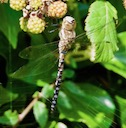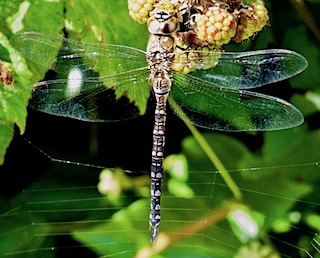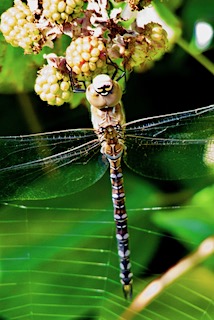 This dragonfly species is on the wing well into the autumn, and can often be seen away from the ponds where it breeds.
This dragonfly species is on the wing well into the autumn, and can often be seen away from the ponds where it breeds.
Photo: Ray Surridge
Scientific name: Aeshna mixta
What to look for:
• Colouring and appearance: Distinctive yellow golf tee-shaped mark at the top of the abdomen. Males have blue pairs of spots on the abdomen and blue eyes. Females are brown with brownish eyes, and also with pairs of spots on the abdomen, but the spots are usually smaller and yellow, though sometimes blue.
• Size: Length, 60 to 65 mm.
• Where: This species breeds in lakes, ponds and even brackish water, but can often be seen flying at some distance from water. Its range in the UK extends into northern England. Globally, it is distributed from central and southern Europe, into northern Africa, the Middle East, Asia, China and Japan.
• When: Flies from July to October
• Similar species: Common Hawker (Aeshna juncea). The Migrant Hawker has more subdued colouring and, unlike A. juncea, the leading edge (costa) of each wing is brown. The Migrant is also distinguished from the Common Hawker by the small golf tee-shaped triangle at the top (second segment) of the abdomen (see photos below).
 Easily confused superficially with its larger relative, the Common Hawker, the Migrant Hawker can be distinguished by the brown costa (leading edge of the wings, which are yellow in the Common Hawker). The Migrant Hawker also has a bit more ‘staying power’, often flying into November.
Easily confused superficially with its larger relative, the Common Hawker, the Migrant Hawker can be distinguished by the brown costa (leading edge of the wings, which are yellow in the Common Hawker). The Migrant Hawker also has a bit more ‘staying power’, often flying into November.
The UK distribution of the Migrant Hawker has been extending northwards since the middle of the twentieth century, before which it was a rare migrant. Now resident and breeding here, it has more recently had its first records on the Isle of Man and in Ireland (1998 and 2000, respectively).
Unlike some other dragonfly species, the Migrant Hawker is not territorial, and can sometimes be seen in feeding swarms, and often far from its watery breeding grounds as it hunts for food. Similar to other Hawker species, this is a fast-flying species that catches prey on the wing.

Did you know…?
…Hawker dragonflies can hover and fly backwards.
… Dragonflies do not go through a pupal stage in their development, unlike butterflies. The adult emerges from the final moult of the larval stage, which takes place above the waterbody surface.
More information and references:
Chinery, M., 2005. Collins Complete Guide to British Insects. Collins, London.
Published: September 2017
Author: Amanda Scott
Photos: Ray Surridge
